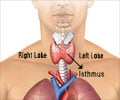New evidence-based recommendations from the American Thyroid Association provide guidance in the management of patients with all forms of thyrotoxicosis.

‘New evidence-based recommendations from the American Thyroid Association (ATA) provide guidance to clinicians in the management of patients with all forms of thyrotoxicosis, including hyperthyroidism.’





The Guidelines, published in Thyroid, a peer-reviewed journal from Mary Ann Liebert, Inc., publisher. The "2016 American Thyroid Association Guidelines for Diagnosis and Management of Hyperthyroidism and Other Causes of Thyrotoxicosis" were coauthored by an international task force of expert clinicians and researchers in the field of thyroidology. Led by Chair Douglas Ross, Massachusetts General Hospital, Boston, MA, the task force provides a solid foundation of knowledge on the scope, potential causes, and clinical consequences of thyrotoxicosis.
The Guidelines include recommendations on how to evaluate patients and diagnose and manage the different types of disease, how to handle thyrotoxicosis in pregnancy, and how to select and implement the various treatment options such as surgery, radioactivity, and antithyroid drugs.
"These ATA guidelines, written by an international and multidisciplinary task force, provide a significant update compared to the previous version published in 2011 because they integrate recent studies and developments in practice trends," says Peter A. Kopp, Editor-in-Chief of Thyroid and Associate Professor of Medicine, Division of Endocrinology, Metabolism, and Molecular Medicine, Northwestern University Feinberg School of Medicine, Chicago. "They form a detailed and balanced framework for the diagnosis and management of patients with different etiologies of thyrotoxicosis that is based on the currently available evidence."
"This is a carefully prepared, well thought out, and comprehensive set of guidelines for the diagnosis and treatment of hyperthyroidism. An invaluable resource for residents, internists, and endocrinologists to have at hand," says Antonio C. Bianco, President of the ATA, President of Rush University Medical Group, and Vice Dean of Clinical Affairs for Rush Medical College.
Advertisement
Source-Eurekalert















